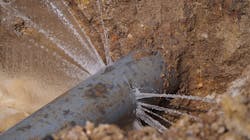Davidson Water, one of America’s largest rural water systems, is located in Lexington, North Carolina.
Entirely supported by rates and fees paid by member customers (no county taxes involved), Davidson Water was established 50 years ago to provide reliable access to clean water to support local commerce and trade.
Today, Davidson manages $146 million in assets: 23 pump stations, a water treatment plant, 26 elevated tanks/standpipes, 66,000 connections, and 1,900 miles of pipeline covering 578 square miles.
Maintaining system functionality remains a key concern for Davidson’s system, 70% of which consists of PVC piping. Over the years, they’ve experienced a significant number of water main breaks, caused mainly by water hammer or transient events. Such events occur due to a variety of reasons, including pump or valve operations, pipe breaks, and changes in water demand.
Water system behavior over time, particularly when subjected to sudden changes in flow or pressure, enormously impacts the operation and maintenance of any water distribution system, and Davidson is no exception.
Davidson’s water main breaks over the years prompted a change in their pipe material specifications. While some original PVC pipe marginally met new manufacturing specs, areas of very high pressure, combined with transients and pipes that barely meet new manufacturing standards, creates a recipe for pipe failure.
Maintaining PVC pipe replacement progress prompted a regular performance of system-wide transient analysis to mitigate the risk of leaks and breaks.
Passing the pressure
Transient analysis plays a critical role in maintaining the operation of water systems by providing key insights into sudden changes in flow, pressure and other operating conditions. If not properly managed, these changes can cause damage, water quality issues and service disruptions.
Performing impactful and frequent transient analysis required a full model of Davidson’s system. Creating an accurate transient model enabled understanding of the dynamics of the entire system, as opposed to only pump stations, in addition to performing ‘what if’ scenarios without actually experimenting in the field.
For example, a primary concern for the team was low pressure. If pressure is too low, or even negative, it may lead to potential health contamination when impurities infiltrate the pipe. Vapor cavities also pose a challenge by creating severe pressure spikes when they collapse.
But perhaps most important for Davidson Water is the issue of pipe replacement. Transient cycling becomes an issue if the utility has a high volume of PVC pipe. Therefore, the team strategically built a model to provide comprehension of the cycling behavior from normal operations.
Modeling the dynamics
Modeling for these specific problems presents unique challenges. Transients are extremely dynamic, and therefore require more than simply evaluating maximum pressure and traditional hand calculations. Vapor cavities pose modeling challenges, as not all modeling software can detect instantaneous pressure spikes from a vapor cavity collapse.
To properly account for these nuances, selecting the most appropriate modeling format was essential.
One possible modeling format involved skeletonization. This approach would simplify modeling of the distribution system by focusing on critical components, removing non-essential components, and simplifying pipes’ physical and hydraulic characteristics. Skeletonization would reduce the time, cost and complexity of computation at the cost of modeling precision.
Although relying on skeletonization would reduce Davidson’s model size and simplify analysis, using this approach to compute transients required rethinking. Model skeletonization overlooks the complex interactions and attenuations of transient pressure waves in dead-ends and low-flow pipes, which are typical targets for skeletonization and model size reduction. This could introduce significant error in estimating extreme pressure transients.
If not addressed with extreme caution, this approach can lead to poorly designed and inadequate transient mitigation strategies or, in some cases, overdesign. In short, the concept of system-wide transient analysis, without the need to skeletonize, becomes critical.
Davidson worked closely with engineering firm Hazen and Sawyer to overcome these challenges.
One example of the projects they regularly tackle is pump replacement. To understand every detail, the team leverages the transient analysis capabilities inside a water distribution system modeling software from Autodesk: InfoWater Pro.
The team uses the software to simulate extreme surge events, allowing them to understand pressure throughout the entire system during transient events, providing much greater decision making on pump size and run times.
Planning pump station upgrades
On one particular project, Davidson sought to upgrade their 0.6 million gallon daily (mgd) Hargrave Pump Station to 2.1 mgd to meet increasing water demands in this pressure zone. The team knew that upgrading Hargrave would correlate to higher flows and velocities downstream, potentially increasing the risk of extreme transient pressures in the event of a pump trip or even during routine operations, such as throttling valves, operating hydrants or activating pumps.
Planning the upgrade required carefully assessing how the pump station draws suction from a higher-pressure zone (940 ft hydraulic grade line) to a lower pressure zone (910 ft hydraulic grade line) to identify water hammer potential in either pressure zones, and to mitigate the risk of transients.
To prepare for this upgrade, the team modeled its water distribution network, including the new Hargrave Pump Station and several new water lines on both the suction and discharge sides. During a power loss, the pump slows down depending on the inertia, making the inertial value extremely important to understand.
When enough pressure exists on the suction side and is higher than the discharge side, water flow does not cease because the energy is always greater on the suction side than the downstream side, ultimately maintaining flow through the station.
The model suggested that the risk of damaging transient pressures during a power outage was small.
Water hammer effects, on the other hand, can be mitigated further by thoroughly testing the model with different types of surge control devices. To take advantage of that in the design, the team added a bypass check valve at the pump station so the water would flow through the check valve instead of through the pump. This enabled the pump to completely shut down.
By experimenting with a bypass check valve to mimic water behavior
as it passes through the station, the team successfully identified several key benefits.
First, reduced pressure fluctuations, which can reduce long-term cyclical pressure stress on distribution piping.
Second, it helped attenuate unforeseen transient surges that might develop in the future.
Lastly, it allowed a substantial volume of water (0.8 mgd) to pass through the pump station when not in operation — and without spinning the pumps.
As a result, Davidson is thoroughly prepared to handle the entire gamut of potential outcomes.
Maintaining the flow
Davidson has already seen a return on its investment from creating a detailed model of its system to enable frequent transient analyzes. Its PVC pipe replacement strategy, for example, has resulted in a 36% decrease in leaks over 10 years. Additionally, the team’s focus on water hammer effects has provided Davidson the clearest and most accurate view possible into the inner workings of their pipes.
Of course, not all pipe breaks and leaks can be avoided, even when applying every high-tech tool. It always helps to attack problems from different angles, which is why last year Davidson Water added an adorable-but-effective new tool: Puddles, the leak detection dog.
This three-year-old chocolate Labrador Retriever is trained to sniff
out off-gassing chlorine in treated water, sometimes down to 4
feet underground.
Ever the innovator, Davidson is also in talks with a satellite imagery provider to potentially utilize mapping technology to identify leakage points of interest in the area, which offers the excellent side effect of making Puddles’ job more efficient — beyond Puddle’s community outreach work with school visits and local events.



